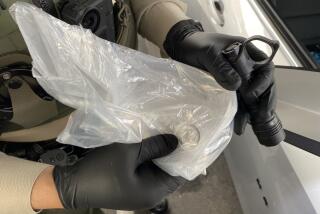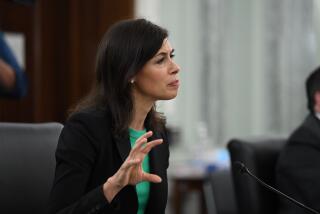Eye on the Sky
COLUMBIA, Md. — Using a car full of high-tech gear to pinpoint a false marine radio distress signal, Charles C. Magin rounded a corner on Maryland’s Kent Island one day last month and flashed his federal badge to six dumbfounded teenagers.
“So who’s been operating the radio?” asked Magin, district director of the Federal Communications Commission’s compliance and information bureau in Maryland. Magin extracted a confession from one of the youths, and police and parents were called. But the shocked suspects, ages 13 to 15, had pressing questions of their own, Magin recalled: “What’s the FCC? Are you, like, part of the Coast Guard or something?”
The Industrial Age had its G-men--federal agents who rose to prominence nabbing bank robbers and other criminals who flourished with the rise of the automobile. The Information Age--fueled by dozens of new wireless services from phones to digital TV--has given rise to a little known, but increasingly important federal enforcement activity: policing the multibillion-dollar airwaves.
At any given moment, in places ranging from Los Angeles to London, there are literally thousands of electronic transmissions flooding the airwaves. They include AM and FM radio, television, cellular phone calls, satellite signals, police walkie-talkies as well as taxicab, marine, citizens band and high-frequency commercial and amateur radios.
Most of these operators require government authorization to broadcast. And the FCC has issued more than 3.5 million licenses to American broadcasters for various classes of wireless service.
But the task of keeping order among the cacophony of transmissions falls to some 250 men and women in the FCC’s compliance and information bureau. They are the federal government’s cybercops. And though their ranks have been thinned by massive budget cuts and layoffs, their work has never been more critical than today.
“We are putting more of our emphasis on enforcement,” said FCC Chairman William E. Kennard, who has been buoyed by a June federal court decision upholding his agency’s authority to shut down on pirate radio operators who had asserted a 1st Amendment right to broadcast without FCC authorization. “If you didn’t police the airwaves, you’d have chaos.”
The Kent Island teenagers, whom the FCC and police declined to identify because they were juveniles, were not arrested. But the FCC and Coast Guard contend the teenagers’ horseplay potentially jeopardized the safety of others by interfering with a real emergency communications.
Around the world, the airwaves have become the lifeblood of modern communications. Nations are increasingly dependent on broadcasting, cellular phones, satellites and other wireless technologies to carry information, provide electronic security and oil the wheels of commerce.
But those wireless communications can be disrupted by a whole host of factors. They include natural phenomenon such as sunspots, as well as human factors like mis-tuned transmission devices, malfunctioning microwave ovens, broken cable TV wires, airwave pranksters or outright subterfuge.
In one recent incident, some commercial fishermen in vessels off the coast of eastern Africa interfered with airline radio communications by commandeering the airline frequency to hold forth about their personal lives, FCC officials said.
The FCC does not keep precise figures on complaints about airwave interference because most cases are detected and resolved with a few phone calls between the FCC and radio operators. What’s more, improvements in consumer equipment have helped slash inadvertent interference from faulty appliances and other common household electronic devices.
But serious incidents of airwave interference still exceed 500 a year and have become so commonplace that Kennard said he is considering asking Congress for permission to give broadcasters the authority to go to court on their own and shut down unlicensed operators without tying up the resources of the FCC.
“I’d like to have more resources to fight this problem,” Kennard said. But in the meantime, he added, “this agency is going to have to be more vigilant in policing the airwaves.”
Despite a one-third reduction in staff in 1996, the FCC’s compliance and information bureau has been able to hold its own by automating much of its surveillance of the airwaves, said bureau chief Richard Lee.
The agency, which used to maintain a sprawling network of agents at listening posts around the country, has replaced most of the sites with computers and automated tracking systems. The remote equipment can scan the skies for radio interference and automatically dial up the FCC’s headquarters and report any anomalies over the phone.
Meanwhile, FCC agents like Magin have been outfitted with state-of-the-art “cybercars.” The vehicles, which look like ordinary late-model passenger cars to the uninitiated, are crammed full of electronic mapping displays, oscilloscopes and airwave listening devices to track down pirates.
“We have been able to do a lot more by using new technology even though we have fewer people,” Lee said.
Indeed, FCC engineers, who work around the clock monitoring a bank of computer displays inside a nondescript seventh-floor room at FCC headquarters, have helped nab scores of airwave outlaws. The bounty includes operators of illegal high-powered citizens band radios, illegal ham radio operators and more than two dozen pirate radio broadcasters. They have also warned hundreds of licensed broadcasters operating on the wrong radio frequencies.
*
In one of the agency’s most famous cases, the FCC was credited with apprehending “Captain Midnight,” the video pirate who in 1986 startled Home Box Office viewers by interrupting a movie on the cable channel with a message protesting HBO’s plans to scramble its satellite-to-Earth signal.
A sharp-eyed FCC engineer noticed on a videotape of the broadcast that Captain Midnight had used a rare type of character generator to display a color-bar, test-pattern background.
“We knew there were only four or five of these things in existence, so we began calling all of the cable studios to determine who had them,” said Jim Higgins, the FCC engineer who helped break the case.
The FCC’s detective work has also uncovered more critical airwave disruptions.
In one instance during a presidential inauguration, the FCC was called in to track down an errant news media walkie-talkie that was interfering with Secret Service communications. The FCC is now often routinely called in during big media events like the Olympics, Super Bowl and inaugurations to prevent such airwave interference.
But some critics say the FCC’s airwave enforcement efforts aren’t always so benign.
In an incident last year, the agency led a task force of U.S. marshals, Customs Service agents and local police that staged a surprise raid on three unlicensed Florida radio stations, including a biker-rock station called Tampa’s Party Pirate that became infamous after several media profiles.
The operator of the station, Doug Brewer, 44, said the agents burst into his house at 6:30 a.m. on Nov. 19, pointed guns at him and his family and forced them to lie down on the floor with muzzles to their ears. Agents conducted a search of the home that lasted several hours.
Brewer claims the task force took everything that seemed related to broadcasting in any way and dismantled his 150-foot radio tower.
“Myself and my wife are just happy to be alive,” Brewer wrote in a statement he issued on Nov. 22. “. . . We really thought we may have been killed on the morning of the raid. The agency suggested they would be glad to ‘kill us’ for our purported crime.”
Joe Casey, deputy director of the FCC’s compliance and information bureau, said the FCC can’t bring criminal charges on its own and added that the agency’s agents don’t carry guns. But he said other task force members were well within their rights to pull guns.
“We had reports that there were weapons present in the building,” Casey said. “The U.S. marshals are very careful about circumstances like that in order to make sure the situation is very safe and controlled before the FCC starts wandering around in different rooms, taking radios apart.”
But airwave pirates such as Pete TriDish say they have no alternative but to violate federal law as long as the FCC refuses to carve out a class of radio licenses for small community broadcasters without deep pockets.
“I feel like the micro-broadcasting community has gotten a bad rap,” said TriDish, a Philadelphia-based radio pirate who says he’s been active in the free-radio movement for nearly a quarter century. “There’s been so much concentration of media ownership in this country that ordinary people don’t have a voice. The FCC’s actions are simply all about enforcing the broadcast monopoly. If the FCC were to find a micro-broadcaster that was interfering with an airplane or another station, I’m the first one to say go in and grab them. But most stations aren’t interfering with anybody.”
The FCC was handed a major legal victory over pirate radio broadcasters last month. The U.S. District Court in San Francisco issued a permanent injunction barring Stephen P. Dunifer, who operated an unlicensed radio station called Free Radio Berkeley, from making any further transmissions without obtaining a license from the FCC.
FCC first became aware of Dunifer’s activities when his broadcasts caused some interference with licensed radio station KQED-FM in Berkeley. Dunifer never denied he was broadcasting without a license but contended it was the 1st Amendment right of people who lacked sufficient financial resources to operate a radio station.
*
Despite the victory, the FCC is bracing for more high jinks as new wireless technologies flood the airwaves and as cheaper and more portable transmission equipment enable pirates to set up operations more quickly and surreptitiously.
“There’ve been more than 100 pirate radio stations and I’d say we’ve shut down 90% of them, but the equipment is still out there floating around and I suspect some will be started up again,” Casey said. “This is something we will have to deal with long term.”
*
Times staff writer Jube Shiver Jr. can be reached via e-mail at jube.shiver@latimes.com.
More to Read
Sign up for Essential California
The most important California stories and recommendations in your inbox every morning.
You may occasionally receive promotional content from the Los Angeles Times.










